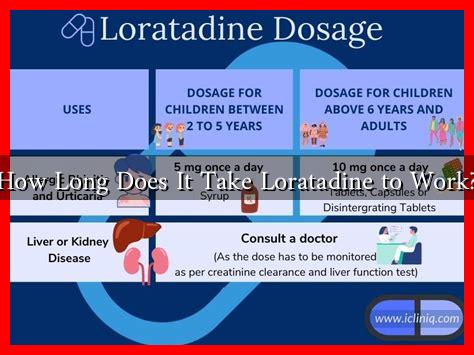-
Table of Contents
How Long Does It Take Loratadine to Work?
Loratadine is a popular antihistamine commonly used to relieve allergy symptoms such as sneezing, runny nose, and itchy eyes. As a second-generation antihistamine, it is known for its effectiveness and minimal sedative effects compared to first-generation antihistamines. However, many users often wonder, “How long does it take loratadine to work?” This article aims to provide a comprehensive understanding of loratadine’s onset of action, factors influencing its effectiveness, and practical usage tips.
Understanding Loratadine
Loratadine is an antihistamine that works by blocking the action of histamine, a substance in the body that causes allergic symptoms. It is available over-the-counter and is commonly marketed under brand names such as Claritin and Alavert. Loratadine is primarily used to treat:
- Seasonal allergic rhinitis (hay fever)
- Perennial allergic rhinitis
- Chronic urticaria (hives)
Onset of Action
The onset of action for loratadine is a crucial factor for those seeking immediate relief from allergy symptoms. According to clinical studies, loratadine typically begins to work within:
- 1 to 3 hours after ingestion
- Peak effectiveness is usually observed around 8 to 12 hours
- Duration of action can last up to 24 hours
This rapid onset makes loratadine a preferred choice for many individuals suffering from sudden allergy flare-ups. For example, a study published in the *Journal of Allergy and Clinical Immunology* found that loratadine significantly reduced symptoms of allergic rhinitis within just one hour of administration.
Factors Influencing Effectiveness
While loratadine is generally effective for most users, several factors can influence how quickly it works:
- Dosage: The standard adult dose is 10 mg once daily. Higher doses may lead to faster relief but should only be taken under medical supervision.
- Individual Metabolism: Each person’s metabolic rate can affect how quickly the drug is processed in the body. Factors such as age, weight, and overall health can play a role.
- Food Intake: Taking loratadine with food may delay its absorption slightly, although it does not significantly affect its overall effectiveness.
- Other Medications: Certain medications can interact with loratadine, potentially altering its effectiveness. Always consult a healthcare provider if you are taking multiple medications.
Practical Usage Tips
To maximize the effectiveness of loratadine, consider the following tips:
- Take loratadine at the same time each day to maintain consistent levels in your system.
- If you miss a dose, take it as soon as you remember, but skip it if it’s almost time for your next dose.
- Avoid alcohol and other sedatives while taking loratadine, as they can enhance drowsiness.
- Consult a healthcare professional if symptoms persist or worsen after taking loratadine for several days.
Conclusion
In summary, loratadine is an effective antihistamine that typically begins to work within 1 to 3 hours, with peak effectiveness occurring around 8 to 12 hours after ingestion. Individual factors such as dosage, metabolism, and food intake can influence its onset of action. By understanding how loratadine works and following practical usage tips, users can effectively manage their allergy symptoms. For more detailed information on loratadine and its uses, you can visit the National Institutes of Health website.

